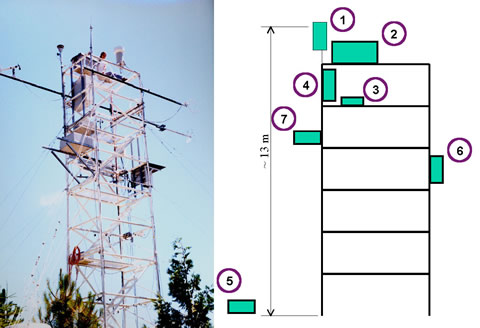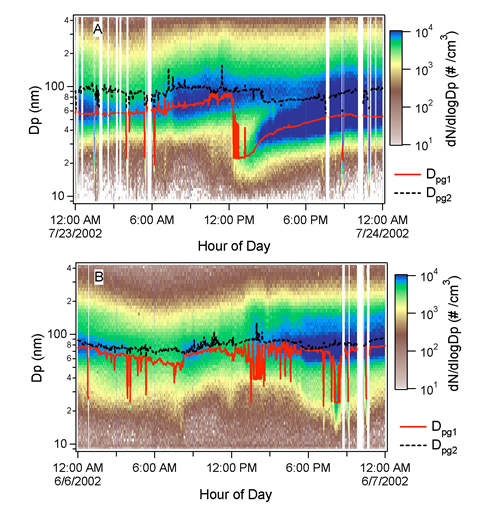Anthropogenic aerosols from populated, industrial, and rural areas result in regional haze that causes significant visibility degradation in areas valued for their scenic beauty, such as the National Parks. These areas are designated as Class I Areas in the Clean Air Act (CAA). Naturally and anthropogenically derived aerosols are treated differently under the Regional Haze Rule.
The summarized visibility goals for the States and Tribes as laid out in Section 308 of the 1999 Regional Haze Rule of the CAA are:
- Prevent degradation of the 20 percent cleanest days.
- Determine a uniform rate of progress for each Class I area needed to return the 20 percent dirtiest days to natural conditions by 2064.
- Establish a reasonable progress goal for each Class I area for 2018.
Implementing the Regional Haze Rule in the West and other parts of the country requires that source apportionment of aerosols into natural (biogenic) and anthropogenic source categories be accomplished. Carbonaceous aerosols are large contributors to visibility degradation (extinction) in the West. The organic carbon (OC) content of atmospheric aerosol has been increasing for the 20 percent dirtiest day in the intermountain west and can be an important component of aerosols in southeast and central California. SOA of biogenic origin can be a significant fraction of this OC aerosol, particularly in heavily forested or rural regions.
To properly apportion the effects of organic aerosols on visibility, it is necessary to quantify the fraction due to primary emissions and to apportion the SOA into that fraction due to anthropogenic and biogenic precursors. Because the atmospheric chemistry that leads to SOA formation is highly complex and non-linear, the only way to predict and apportion SOA is to build and use models that accurately describe the formation of SOA from precursor emissions.
Project Results
Atmospheric aerosols from natural and anthropogenic processes have both primary and secondary origins and can influence human health, visibility, and climate. One key process affecting atmospheric concentrations of aerosols is the formation of new particles and their subsequent growth to larger particle sizes.
A field study was conducted at the Blodgett Forest Research Station in the Sierra Nevada Mountains of California from May through September of 2002 to examine the effect of biogenic volatile organic compounds (VOCs) on aerosol formation and processing. The study included in-situ measurements of concentration and biosphere-atmosphere flux of VOCs, ozone, aerosol size distribution, aerosol physical and optical properties, and meteorological variables. Fine-particle growth events were observed on about 30 percent of the 107 days, with complete size-distribution data. Average particle growth rates measured during these events were 3.8 ± 1.9 nanometers per hour. Correlations among aerosol properties, trace gas concentrations, and meteorological measurements were analyzed to determine conditions conducive to fine-particle growth events.
Growth events were typically observed on days with a lesser degree of anthropogenic influence, as indicated by lower concentrations of black carbon, carbon monoxide, and total aerosol volume. Days with growth events also had lower temperatures, increased wind speeds, and larger momentum flux. Measurements of ozone concentrations and ozone flux indicate that gas-phase oxidation of biogenic VOCs occurs in the canopy, strongly suggesting that a significant portion of the material responsible for the observed particle growth are oxidation products of naturally emitted, very reactive organic compounds.
Benefits
This research will contribute to quantifying the portion of visibility degradation attributable to natural sources by supporting the development of models used to determine the aerosol loading resulting from biogenic emissions. The research will provide sound science required for the equitable implementation of the Regional Haze Rule. The results are important for the various regions of the country where oil and gas exploration and production occur: the States and Tribes in the Central Rocky and the Gulf Coast regions and Kern County, CA. This will greatly improve the modeling of visibility that is important for implementing the Regional Haze Rule and contribute to aerosol source apportionment, which is necessary for permitting oil and gas operations. The research will be useful to the Environmental Protection Agency and the Departments of Energy, Interior, and Agriculture because of energy and environment concerns and their role in implementing the Regional Haze Rule. The research sponsorship should be at the federal level because industry sponsorship often is viewed as self-serving.
Project Summary
Formation of SOAs is important because they contribute significant particle mass in urban and rural areas. SOAs are derived from volatile and semi-volatile hydrocarbon emissions from the biosphere, fuels and their combustion products from mobile sources, and operations concerned with oil and gas exploration and production. SOAs and their precursors influence atmospheric processes at the urban, regional, and global scales and potentially affect visibility, ozone chemistry, ambient PM2.5 (particle mass having diameters of 2.5 microns or less) concentrations, actinic flux, global climate, and human health. There is a need to improve our scientific understanding of SOA formation to build more-robust models for particles, ozone, and visibility. These models must be representative of actual atmospheric conditions that involve the transport and transformation of emissions over urban and regional scales.
In response to this need, the researchers are conducting experimental, analytical, and modeling research whose objective is to investigate SOA formation under actual field conditions to establish a rich data set that will be analyzed to characterize SOA formation from hydrocarbon emissions from a number of sources, at the regional scale. The understanding of SOAs derived from these studies will contribute to model development and model benchmarking.





